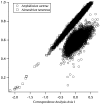Transcriptome Analysis of Core Dinoflagellates Reveals a Universal Bias towards "GC" Rich Codons
- PMID: 28448468
- PMCID: PMC5450531
- DOI: 10.3390/md15050125
Transcriptome Analysis of Core Dinoflagellates Reveals a Universal Bias towards "GC" Rich Codons
Abstract
Although dinoflagellates are a potential source of pharmaceuticals and natural products, the mechanisms for regulating and producing these compounds are largely unknown because of extensive post-transcriptional control of gene expression. One well-documented mechanism for controlling gene expression during translation is codon bias, whereby specific codons slow or even terminate protein synthesis. Approximately 10,000 annotatable genes from fifteen "core" dinoflagellate transcriptomes along a range of overall guanine and cytosine (GC) content were used for codonW analysis to determine the relative synonymous codon usage (RSCU) and the GC content at each codon position. GC bias in the analyzed dataset and at the third codon position varied from 51% and 54% to 66% and 88%, respectively. Codons poor in GC were observed to be universally absent, but bias was most pronounced for codons ending in uracil followed by adenine (UA). GC bias at the third codon position was able to explain low abundance codons as well as the low effective number of codons. Thus, we propose that a bias towards codons rich in GC bases is a universal feature of core dinoflagellates, possibly relating to their unique chromosome structure, and not likely a major mechanism for controlling gene expression.
Keywords: codon bias; dinoflagellate; gene expression; toxin.
Conflict of interest statement
The authors declare no conflict of interest.
Figures








Similar articles
-
A general model of codon bias due to GC mutational bias.PLoS One. 2010 Oct 27;5(10):e13431. doi: 10.1371/journal.pone.0013431. PLoS One. 2010. PMID: 21048949 Free PMC article.
-
Gene expression, nucleotide composition and codon usage bias of genes associated with human Y chromosome.Genetica. 2017 Jun;145(3):295-305. doi: 10.1007/s10709-017-9965-y. Epub 2017 Apr 18. Genetica. 2017. PMID: 28421323
-
Codon Usage Optimization in the Prokaryotic Tree of Life: How Synonymous Codons Are Differentially Selected in Sequence Domains with Different Expression Levels and Degrees of Conservation.mBio. 2020 Jul 21;11(4):e00766-20. doi: 10.1128/mBio.00766-20. mBio. 2020. PMID: 32694138 Free PMC article.
-
Analysis of codon usage patterns in Taenia pisiformis through annotated transcriptome data.Biochem Biophys Res Commun. 2013 Jan 25;430(4):1344-8. doi: 10.1016/j.bbrc.2012.12.078. Epub 2012 Dec 23. Biochem Biophys Res Commun. 2013. PMID: 23268345 Review.
-
Analysis of synonymous codon usage patterns in the edible fungus Volvariella volvacea.Biotechnol Appl Biochem. 2017 Mar;64(2):218-224. doi: 10.1002/bab.1538. Epub 2016 Dec 15. Biotechnol Appl Biochem. 2017. PMID: 27696508 Review.
Cited by
-
Viral proteins as a potential driver of histone depletion in dinoflagellates.Nat Commun. 2018 Apr 18;9(1):1535. doi: 10.1038/s41467-018-03993-4. Nat Commun. 2018. PMID: 29670105 Free PMC article.
-
A Global Approach to Estimating the Abundance and Duplication of Polyketide Synthase Domains in Dinoflagellates.Evol Bioinform Online. 2021 Jul 14;17:11769343211031871. doi: 10.1177/11769343211031871. eCollection 2021. Evol Bioinform Online. 2021. PMID: 34345159 Free PMC article.
-
Lost in translation: conserved amino acid usage despite extreme codon bias in foraminifera.mBio. 2025 Apr 9;16(4):e0391624. doi: 10.1128/mbio.03916-24. Epub 2025 Mar 5. mBio. 2025. PMID: 40042280 Free PMC article.
-
Unveiling the functional nature of retrogenes in dinoflagellates.Open Biol. 2025 Apr;15(4):240221. doi: 10.1098/rsob.240221. Epub 2025 Apr 23. Open Biol. 2025. PMID: 40262635 Free PMC article.
-
An aerobic eukaryotic parasite with functional mitochondria that likely lacks a mitochondrial genome.Sci Adv. 2019 Apr 24;5(4):eaav1110. doi: 10.1126/sciadv.aav1110. eCollection 2019 Apr. Sci Adv. 2019. PMID: 31032404 Free PMC article.
References
-
- Harada T., Oshima Y., Yasumoto T. Structures of two paralytic shellfish toxins, gonyautoxins V and VI, isolated from a tropical dinoflagellate, Pyrodinium bahamense var. compressa. Agric. Biol. Chem. 1982;46:1861–1864.
-
- Baden D.G. Brevetoxins: Unique polyether dinoflagellate toxins. FASEB J. 1989;3:1807–1817. - PubMed
-
- Seki T., Satake M., Mackenzie L., Kaspar H.F., Yasumoto T. Gymnodimine, a new marine toxin of unprecedented structure isolated from New Zealand oysters and the dinoflagellate, Gymnodinium sp. Tetrahedron Lett. 1995;36:7093–7096. doi: 10.1016/0040-4039(95)01434-J. - DOI
MeSH terms
Substances
Grants and funding
LinkOut - more resources
Full Text Sources
Other Literature Sources
Miscellaneous

